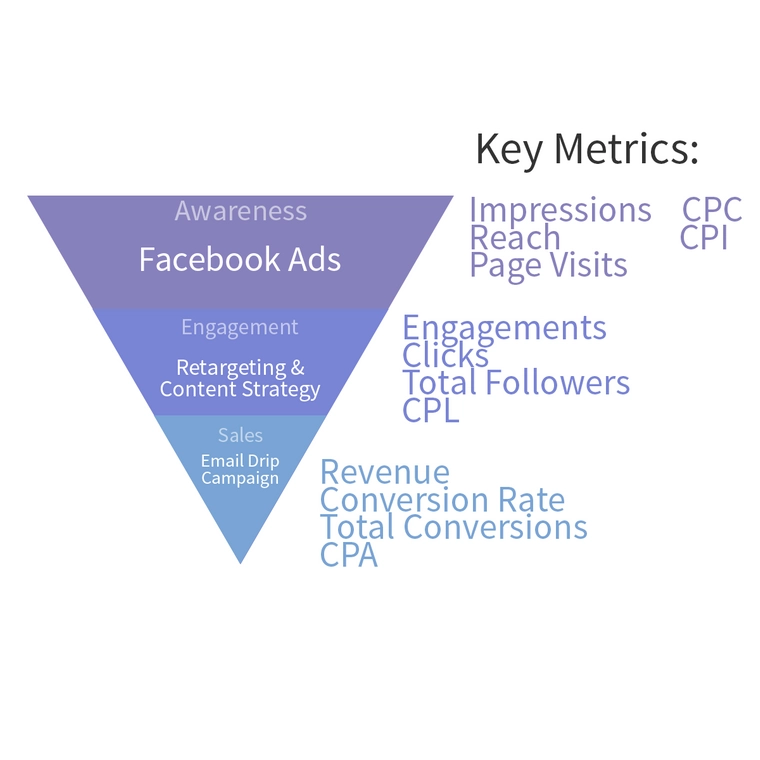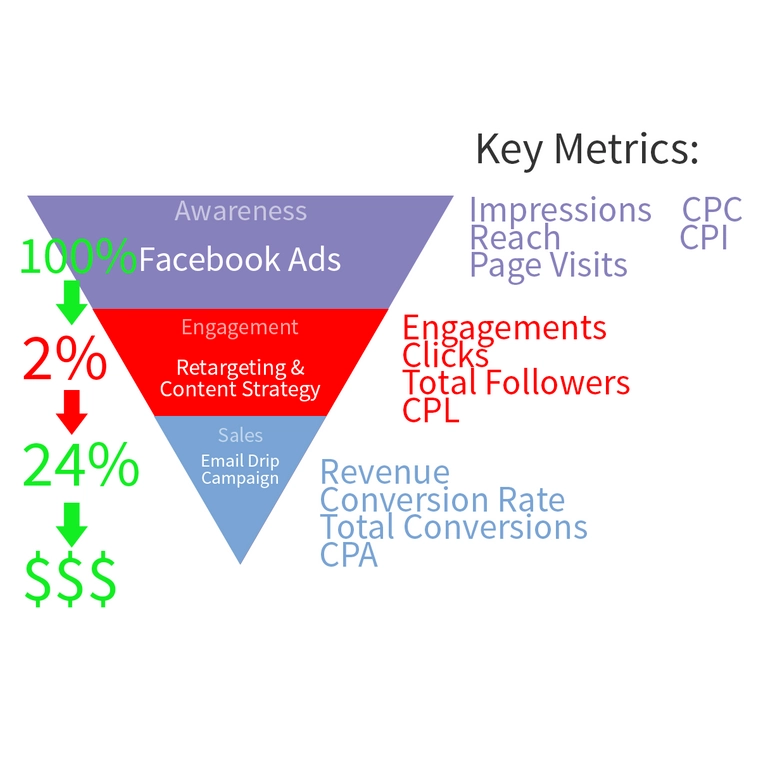
7 Easy Steps to Making a Profitable Social Media Sales Funnel
Are you looking to turn your social media into a revenue stream of its own?
You may be building up a large following, but have trouble turning your followers into customers.
Or you might be having trouble getting people to know you exist, let alone wanting buy something from you.
This is where your social media sales funnel comes in, you can make potential customers know who you are and turn them from strangers into sales.
Keep on reading to learn how to make your own social media sales funnel that actually turns a profit in 7 easy steps.
1. Understand the Sales Funnel
Understanding how your sales funnel is going to work is the first step to creating a successful sales funnel.
Sales funnels come in plenty of different flavors online, but we’re going to use a minimalistic sales funnel which follows the stages of awareness, engagement and sales.

I like to use this model of a sales funnel because it’s:
- Simple to use and explain.
- Effective at producing results.
- Easy to break down your existing processes into stages of the sales funnel.
Let’s break down the separate stages:
- Awareness – Making strangers aware that you exist by getting in front of their eyeballs.
- Engagement – Turning people who know that you exist into followers by engaging with them repeatedly.
- Sales – Turning your followers into customers by providing a value proposition they would act on.
2. Define your target audience
Before you start reaching out to strangers, you have to figure out what your ideal customer looks like.
Establishing a full persona profile of your ideal customer that’s as granular as possible helps you to build your sales funnel to cater to the type of person you want, as well as improve your ability to effectively target your ideal customer.
Some questions you could ask to help build your own persona profile include:
- How old are they?
- Where do they live?
- What’s their profession?
- What are their problems?
- Who do they trust?
- What motivates them to buy something?
- What makes then annoyed?
- How do they find out about new products?
- What do they use to learn new information or skills?
The more information you map out about your ideal persona, the easier it is to connect with people that fit your description and get inside their heads.
This also brings life and a human connection into your marketing and sales strategies, as often its way too easy to forget that you’re not just dealing with numbers.
3. Define your channels
Now that you know who your ideal customer is, you’ve got to figure out where to find them on social media.
Does your target audience spend time engaging with brands on Facebook? Do they watch a lot of guide videos on YouTube? Or do they spend their time looking for help on Reddit?
Once you know where to find them you’ve got to figure where you will engage with them and convert them.
Not all channels are built equally for every stage of your sales funnel; Facebook may be great for awareness and engagement but not for converting sales whereas email marketing may be great for conversions but not building awareness or engagement.
Your channels may look like something like this:

4. Define your key metrics
So you’ve figured out who your target audience is and what your channels will be, how do you know if it’s working?
Bottlenecks in your funnel are a conversion rate killer; you need to establish a reliable way to measure the performance of each stage of your funnel by assigning key metrics to track.
Usually they look something like this:
- Awareness: Impressions, reach, page visits, cost per click, cost per impression.
- Engagement: Engagements (comments, likes, shares), clicks, total followers, cost per like.
- Sales: Conversion rate, total conversions, revenue, cost per acquisition.
This is what our sales funnel looks like with our key metrics against our channels:

5. Implement your funnel
You’ve got all the information behind you on how to build your social media sales funnel, now it’s time to implement it!
If you’ve followed the previous steps this part should be easy, it’s just a matter of turning all your planning and research into a working funnel.
6. Review your funnel’s performance
Hopefully your sales funnel is successfully turning strangers into sales.
Regardless of whether or not it is, I guarantee you can make your funnel even better.
No one’s going to create a perfect social media sales funnel the first time, but before you start chopping and changing everything take a look at your funnel’s current performance.
Using the key metrics we set up earlier, you should be able to assess how every stage of your funnel is doing and figure out what’s the weak link in the chain.

If I’m getting a lot of impressions but very little engagement & page likes, I know I’ve got to revise my engagement stage of the funnel.
7. Tweak & Repeat
Let’s say you’ve identified that your engagement stage of the funnel is the weak link, the next step is to go back and tweak it to be better.
Ask yourself questions like:
- How would my ideal customer engage with this part of my funnel?
- Is this the right channel for this stage of my funnel?
- Am I looking at the right key metrics for this stage of the funnel?
- What do my competitors do for this stage of the funnel?
- Would this stage of the funnel work on me? Why or why not?
If you feel stuck on how to improve a stage in your funnel, try something completely different to your current approach to get a fresh perspective, combine what works and scrap what isn’t.
Remember you’re never going to get it perfect the first time, keep on looking at your funnel with a critical eye and always look for ways to make it even better.
Conclusion
That sums up how to make your own social media sales funnel and transform strangers into customers.
Its human nature to go through stages before reaching a decision and if you capture that journey you can turn your social media channels into profitable revenue streams.


